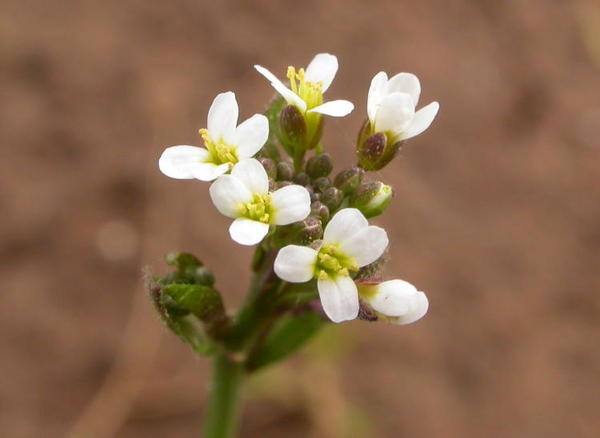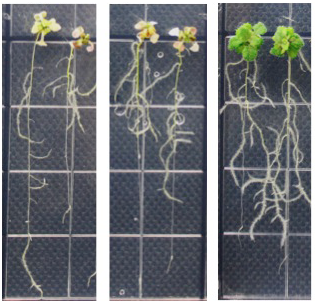Madison, Wisconsin, USA
April 3, 2014

Simon Gilroy and colleagues showed what long had been suspected but long had eluded scientists: that calcium is involved in rapid plant cell communication, as discovered in Arabidopsis thaliana (above). No one had ever been able to see it before. Photo: Oregon State University
 For Simon Gilroy (pictured), sometimes seeing is believing. In this case, it was seeing the wave of calcium sweep root-to-shoot in the plants the University of Wisconsin-Madison professor of botany is studying that made him a believer.
For Simon Gilroy (pictured), sometimes seeing is believing. In this case, it was seeing the wave of calcium sweep root-to-shoot in the plants the University of Wisconsin-Madison professor of botany is studying that made him a believer.
Gilroy and colleagues, in a March 24, 2014 paper in the Proceedings of the National Academy of Sciences, showed what long had been suspected but long had eluded scientists: that calcium is involved in rapid plant cell communication.
It's a finding that has implications for those interested in how plants adapt to and thrive in changing environments. For instance, it may help agricultural scientists understand how to make more salt- or drought-tolerant plants.
"How do you think plants live?" Gilroy asks. "If I poke you, I see an instant response. You move away. Plants live in a slightly different world. They are rooted to the ground, literally, and they respond to the world either by growing or creating chemicals."
Calcium is involved in transmitting information in the cells of humans and other animals, contracting muscles, sending nerve signals and more.
In plants, scientists believed it had to also play a role in processing information and sending rapid signals so that plants can respond quickly to their environments.

Arabidopsis thaliana growing in salt water. The plant on the right has more of the protein channel TPC1, thought to be involved in calcium signaling in plants. The plant at center has less TPC1 than normal, and the one on the left is considered normal. Photo: Won-Gyu Choi/Gilroy Lab
Imagine you are a plant being eaten by a caterpillar: "It's like a lion chewing your leg," says Gilroy. "If an insect is chewing your leaf, you're gone unless you determine something effective immediately."
But no one had ever been able to see it before. Even Gilroy's team found it by accident.
The team was using a specific calcium sensor they thought wasn't going to work. They speculated it could serve as a control in their studies.
The sensor's brightness changes in the presence of calcium, displayed on screen as a change from green to red through a process known as fluorescence resonance energy transfer, or FRET. Typically, this particular sensor is so sensitive to calcium it is nearly always red.
But when researchers applied stress to the tip of a plant's roots — a high concentration of sodium chloride salt — it triggered a wave of red that traveled rapidly from the root to the top of the plant.
"We were kind of like, 'Why is it even working?' says Gilroy. "It was probably telling us we were looking in the wrong realm. It's like we could only hear the people shouting and we couldn't hear the talking."
The calcium wave, a flush of red on an otherwise green palette, traveled on a scale of milliseconds, traversing about eight plant cells per second — too quick to be explained by simple diffusion of salt.
"It fit with a lot of our models," Gilroy says. "But the idea that it's a wave is one step beyond what our models would predict."
Within 10 minutes of applying a small amount of salt to the plants' roots, typical stress response genes were turned on in the plant.
Also turned on was the machinery to make more of a protein channel called two pore channel 1 (TPC1). Within one-to-two minutes, there was 10 times more of the building blocks needed to make the channel, which is thought to be involved in calcium signaling.
Gilroy and his team then looked at plants with a defect in TPC1. They had a much slower calcium wave — about 25 times slower — than plants with normal TPC1. When they studied plants expressing more of the TPC1 protein, the calcium wave moved 1.7 times faster.
Plants with more channels also grew larger and contained more chlorophyll than plants with normal or mutated TPC1 when grown in salt water.
The protein channel is present in all land plants, says Gilroy, and it's found throughout the plant. This is one of the many reasons it surprised the team to learn the calcium wave moves only through specific cells in the plant, like electrical signals moving through nerve cells in humans and other animals.
"We weren't expecting that," Gilroy says. "It means specific cell types have specific functions ... there must be something special about those cells. We're really at the beginning."
The lab is now looking at the molecular machinery that makes up TPC1, to figure out how the parts of the channel work.
And now that the scientists know that calcium talks, the volume is turned up. The work is just getting started.
"We can hear the screaming," says Gilroy. "Now we're trying to see what the vocal chords are doing."